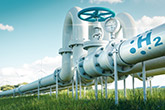Joby demonstrates potential of hydrogen-electric flight
Published by Poppy Clements,
Assistant Editor
Global Hydrogen Review,
JoeBen Bevirt, Founder and CEO, Joby, said: “Travelling by air is central to human progress, but we need to find ways to make it cleaner. With our battery-electric air taxi set to fundamentally change the way we move around cities, we’re excited to now be building a technology stack that could redefine regional travel using hydrogen-electric aircraft. Imagine being able to fly from San Francisco to San Diego, Boston to Baltimore, or Nashville to New Orleans without the need to go to an airport and with no emissions except water. That world is closer than ever, and the progress we’ve made towards certifying the battery-electric version of our aircraft gives us a great head start as we look ahead to making hydrogen-electric flight a reality."
The landmark test flight, believed to be the first forward flight of a vertical take off and landing aircraft powered by liquid hydrogen, was completed last month using a converted Joby pre-production prototype battery-electric aircraft fitted with a liquid hydrogen fuel tank and fuel cell system. It landed with 10% of its hydrogen fuel load remaining.
Jacob Wilson, (Acting) Branch Chief, AFWERX Agility Prime, said: "Agility Prime has been very supportive of hydrogen-powered aircraft development and testing as it aligns with the programme’s goals to advance transformative vertical lift technologies and broader Department of Defence operational energy goals of energy substitution and diversification, and energy demand reduction."
Joby’s hydrogen-electric demonstrator is part of the company’s future technology programme and is the result of several years of collaboration between a small team at Joby and H2FLY, Joby’s wholly-owned subsidiary based in Stuttgart, Germany. The converted aircraft previously completed more than 25 000 miles of testing as a battery-electric aircraft at Joby’s base in Marina, California, US.
Using the same airframe and overall architecture as Joby’s core, battery-electric aircraft, this demonstrator features a liquid hydrogen fuel tank, designed and built by Joby, which stores up to 40 kg of liquid hydrogen, alongside a reduced mass of batteries. Hydrogen is fed into a fuel cell system, designed and built by H2FLY, to produce electricity, water, and heat. The electricity produced by the hydrogen fuel cell powers the six electric motors on the Joby aircraft, with the batteries providing additional power primarily during take-off and landing.
Joby’s H2FLY team used similar technology to complete another record-breaking flight in September 2023, when they flew the world’s first piloted flight of a conventional liquid hydrogen-electric aircraft using their fuel cell technology.
As part of Joby’s wider commitment to leading the way on the development of new aviation technologies, it recently acquired Xwing Inc., an industry leader in the development of autonomous technology for aviation. Xwing has been flying autonomous aircraft since 2020, with 250 fully autonomous flights and more than 500 auto-landings completed to date, using the Superpilot software it developed in-house.
Joby plans to start commercial operations as soon as 2025, using its battery-electric air taxi.
Read the article online at: https://www.globalhydrogenreview.com/hydrogen/11072024/joby-demonstrates-potential-of-hydrogen-electric-flight/
You might also like
H2APEX becomes sole owner of hydrogen project in Lubmin
APEX Nova Holding GmbH has become the sole owner of all shares in HH2E Werk Lubmin GmbH (HH2E) following the completion of the insolvency plan proceedings.

